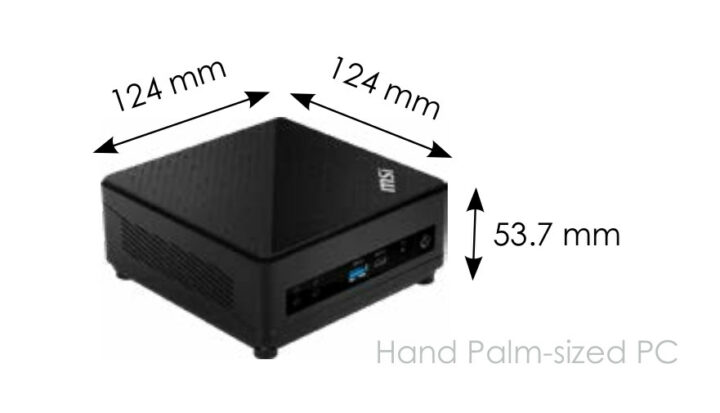MSI Cubi N ADL is one of the first mini PCs based on the Alder Lake-N processor family. The mini PC will be offered with Intel Processor N100 or N200 quad-core processor and up to 16GB RAM, as well as M.2 SSD and 2.5-inch SATA storage support.
The low-power mini PC also offers 4Kp60 capable HDMI and DisplayPort video output ports, two Gigabit Ethernet ports, WiFi 5 and Bluetooth connectivity, and a range of USB ports.
MSI Cubi N ADL specifications:
- SoC
- Intel Processor N100 quad-core processor @ up to 3.4 GHz (Turbo) with 6MB cache, 24EU Intel HD graphics; TDP: 6W
- Intel Processor N200 quad-core processor @ up to 3.7 GHz (Turbo) with 6MB cache, 32EU Intel HD graphics; TDP: 6W
- System Memory – Up to 16GB single channel DDR4 3200MHz memory via one SO-DIMM socket
- Storage
- 1x M.2 SSD (auto switch)
- 1x 2.5-inch SSD / HDD
- Video Output – HDMI 2.0b up to 4Kp60, DisplayPort 1.4 up to 4Kp60
- Audio – 1 x Mic-in/ Headphone-out combo
- Networking
- 2x Gigabit Ethernet RJ45 ports
- Intel AC3168 (Wi-Fi 5 and Bluetooth 4.2) or AC9462 (Wi-Fi 6 and Bluetooth 5.1) module
- USB – 2x USB 3.2 Gen 2×1 Type-A ports, 1x USB 3.2 Gen 2×1 Type-C With DP Alt Mode, 2x USB 2.0 Type-A
- Misc – 1x Kensington Lock
- Power Adapter – 65W
- Dimensions – 124 x 124 x 53.7 mm
The Cubi N ADL mini PC will ship with Windows 11 Home or Pro, and should deliver a noticeable boost in performance compared to Jasper Lake mini PC. Intel claims the CPU performance of the Processor N200 processor should improve by up to 28% compared to the Pentium Silver N6000 (Jasper Lake) based on CrossMark results, and we should also expect a boost of up to 64% GPU performance based on 3Dmark results.
MSI has not listed the Cubi N ADL on its website, and I found out about the Processor N100/N200 mini PC through Liliputing where Brad Linder discovered the new Alder Lake-N computer in a product brochure. There’s no word about availability or pricing, but hopefully, it will be launched within the next few months, and pricing should be in the range of current Jasper Lake mini PCs.

Jean-Luc started CNX Software in 2010 as a part-time endeavor, before quitting his job as a software engineering manager, and starting to write daily news, and reviews full time later in 2011.
Support CNX Software! Donate via cryptocurrencies, become a Patron on Patreon, or purchase goods on Amazon or Aliexpress






The clarification about this being a *hand* palm-sized PC in the picture is very thoughtful. Some simians might get coonfused otherwise.
One channel memory? Why do they keep doing that? At least solder down one bank of memory of a reasonable amount (4GB?) and let the end application user populate or not the other bank with an SO-DIMM.
It looks like it’s a limitation of the Alder Lake N-series processors. At least, it’s what shows up in Intel Ark “Max # of Memory Channels: 1”.
Interesting. They didn’t cover that in their initial processor annoucement. So these really are an ATOM product line and not just a super low end laptop chip. With Intel and their rampant segmenting of products, it’s never clear what the providence of a chip is.
Isn’t it just normal ‘product segmentation’ with Alder Lake-N having just a single RAM channel, smaller caches, lower burst clocks, less PCIe lanes and so on…
There’s even a differentiation in max amount of RAM according to Ark: Alder Lake-N limited to 16 GB, ‘mobile’ Alder/Raptor Lake are specced with 64 GB and the ‘Desktop’ variants with 128 GB.
> At least solder down one bank of memory of a reasonable amount (4GB?)
Honestly if there’s soldered memory then I would prefer LPDDR5 (where single vs. dual channel doesn’t matter that much wrt performance) but if there were two channels available then I would prefer two SO-DIMM slots. Since AFAIK you still need two identical modules (at least timings-wise) to get some performance benefits when equipping both slots?
That’s a challenge that LPDDR5 brings to the table that we didn’t really suffer from with DDR3–the LP variants weren’t higher performing, just lower power. When DDR4’s LP variants offered better performance and lower power (and got huge adoption in mobile devices), things changed. LPDDR5 has only made the situation more extreme as the LP variant has a higher relative performance advantage.
I’m not sure what the limitations that Intel’s memory controllers have WRT driving dissimilar memory. They can handle different sizes, but you’re right that–at least historically–they would run at the lowest common denominator of performance be that clock speed or timings. But always the same timings. I assue that’s because they can save logic between the different banks. There’s no reason they would have to do that. They could choose to make the channels completely independent–I wonder if they did move in that direction with some of their server systems. Remember when they talked about enabling NV-DIMM support some time back? I can’t imagine you’d operate those with the same timings and speeds as the rest of the DRAM in the system.
At least the single channel would of made more sense as DDR5 for the iGPU.
MSI is selling the “MSI CUBNADL021 Pen N100/4G/128G/W11P” on Amazon for $289.